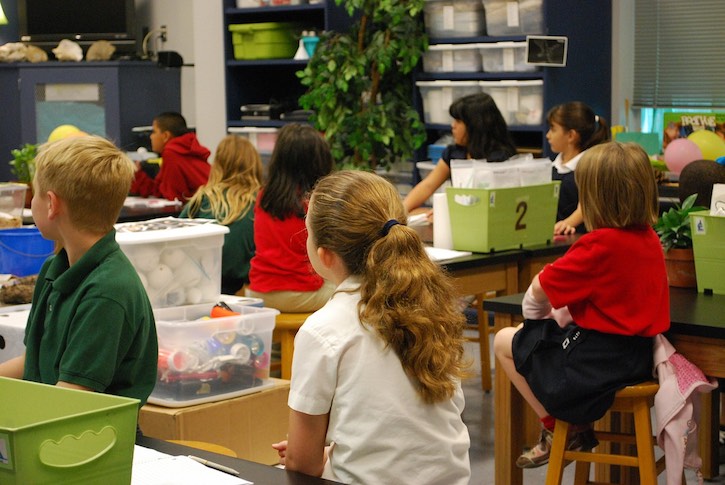The “digital divide” was a term originally coined in the early 2000s to describe the “have” and “have-nots” of computers and mobile technology. There was great concern that low-income children would be left behind because of their lack of technology in the home. In the United States, the middle-class predominantly white families who were able to afford computers (and later mobile technology) were able to allow their child to experience (and learn) so much more through the internet accessed on these devices. A number of things addressed these fears, including the decreasing cost of computers. This helped bridge the digital divide, but nothing had quite the effect of the one-to-one programs we now see in so many school districts, including those in low-income areas. All children could have access to the internet. Digital Divide closed. The problem is there is little evidence to support the idea that technology in schools improves learning outcomes.
The ”New Digitial Divide” which came next was all about stable, high-speed internet access. The children have computers, but are they able to reliably access all the wonderful things on the internet equally?
Recently, we have started to see a shift in the conversations about the digital divide in the United States. The Screenagers documentary highlights a concerning trend: when those shiny laptops head home, children’s grades in reading and math go down. When high-speed internet access is provided to an area that previously did not have it, research shows the same thing: academic achievement declines. And, what’s worse? Those declines are the worst for the low income families we were supposedly worried about in the first place.
 Despite the research, the doling out of laptops like candy on Halloween is not slowing. It’s spreading. Originally, one-to-one policies originated in high schools. Middle school is becoming the norm with some schools instituting one-to-one in elementary. Finished your work? Unplug your laptop from its docking station and play an “educational” game. Why? Because one-to-one programs are big business. A recent New York Times article highlighted how tech companies court school districts much like big pharma’s relationship with prescribing doctors. The business of selling computers and associated software to well-meaning school districted is an industry expected to reach $21 billion in sales by the year 2020.
Despite the research, the doling out of laptops like candy on Halloween is not slowing. It’s spreading. Originally, one-to-one policies originated in high schools. Middle school is becoming the norm with some schools instituting one-to-one in elementary. Finished your work? Unplug your laptop from its docking station and play an “educational” game. Why? Because one-to-one programs are big business. A recent New York Times article highlighted how tech companies court school districts much like big pharma’s relationship with prescribing doctors. The business of selling computers and associated software to well-meaning school districted is an industry expected to reach $21 billion in sales by the year 2020.
So what’s a Concerned Parent to do?
I recently participated in a panel discussion on technology and kids following a screening of Screenagers at a local school’s education night. The panel then answered the moderator pre-prepared questions about how to manage screen-use, but I felt like we were missing the mark. We were not interacting with the parents, hearing their concerns. As I walked out, my fear was confirmed. I heard parents complaining to the school staff that this was not the information they needed. They know and see the problem with tech infiltrating their children’s every moment. I overhead a parent complaining to administrators that they had always monitored screen-time, but when the laptops were sent home, everything spiraled out of control. Homework is on the computer and often online, and the parents’ ability to monitor screen-time has been hijacked.
It Depends on Your Income Level
Increasingly, families with resources are electing private schools, particularly Montessori or Waldorf inspired options which minimize technology in comparison to skills like sustained attention, learning through play, utilizing real materials and developing social skills. Montessori and Waldorf schools have distinct educational philosophies, but come with hefty price tags, often between ten and twenty thousand dollars per year in the United States. News articles about tech-insiders like Steve Jobs and Bill Gates choosing low-tech lifestyles and schools for their children proliferate the World Wide Web they helped to mainstream. Just this past week, Entrepreuner.com ran an article about the tech moguls choices of schooling. Business Insider followed suit and ran an article about the desire of those “in-the-know” to choose low-tech schooling for their own offspring. In that article, Sherry Turkle, a psychologist and research at MIT said the trend of schools to use devices to create “personalized” lessons plans for children is “Too much. Too much. Too much.” She emphasizes that kids need to work together face-to-face.

Another subgroup of families are opting for home-schooling, with the rates of home-schooling in the United States rising dramatically. Research from 2007 indicated 1.5 million children were homeschooled in the United States. That’s a steady increase from 1.1 million children in 2003 and 850,000 children in 1999. The National Center for Policy Analysis says that number has grown to 2.5 million children today. That means home-schooling has nearly tripled in less than 20 years. Parents are increasingly choosing to home school children for a variety of reasons, many of which have to do with dissatisfaction with traditional schooling which increasingly emphasizes regimented learning, testing along with minimal time spent outdoors and in play-based and discovery-based learning activities. The over-use of screens in traditional public schools is increasingly becoming part of the concern of parents who chose to home-school their children. Home-schooling has it’s celebrity endorsers too. Will Smith and Jada Pinket-Smith homeschool their children. About the choice they say, “We don’t want our kids to memorize. We want them to learn.” Homeschooling may not force a parent to shell out $20,000 per year upfront but certainly there are costs with the loss of income from a parent and supplies which may make it impossible for the majority of the population.
The Digital Divide in School Choice
These recent articles are missing a big piece of the puzzle. Yes, those “in-the-know” choose low-tech options for schooling. But, it’s not because they are in-the-know. It’s because they have the choice. Many parents see negative effects of the screen push in their children’s schooling and would love to choose a low-tech educational option. But, they financially cannot afford to make that choice. This is the new digital divide: high-income parents can opt out of the over-use of technology in schools. Many parents, especially lower-income parents do not have the freedom. Instead, they try to swim upstream and regulate over-use in an educational world that is pushing it for younger and younger children.
Join The Revolution
The post The Rich Get Smart, The Poor Get Technology: The New Digital Divide in School Choice appeared first on screenfreeparenting.com.




















